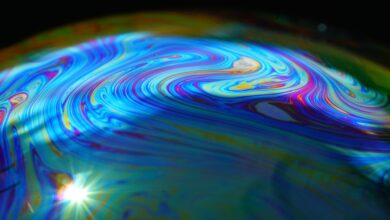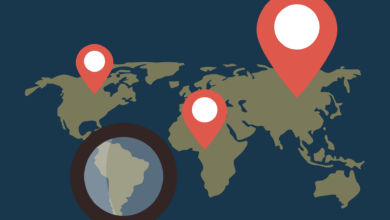Top Remote Sensing Software for Efficient Data Analysis
Looking for the best remote sensing software to efficiently analyze data? Check out our top picks for powerful and accurate programs that can help streamline your remote sensing workflows and enhance your productivity. From advanced features to user-friendly interfaces, these tools are designed to provide you with the insights you need to make informed decisions in your projects. Find out which remote sensing software is right for you and take your analysis to the next level.

Contents
Top Remote Sensing Software for Efficient Data Analysis
There are countless tools to process data for remote sensing From satellite imagery to LIDAR data, however, this article cartogeek.com reflects some of the most important software for managing this type of data. Before launching the software, it should be noted that there are different types of data according to the way they are purchased, whether it is active satellite / indirect or UAV’s.
Software for processing non-active sensory data
QGIS: Quantum GIS is an open GIS site, over the years it has incorporated a variety of work and finishing styles so that the analyst has the potential for processing and access to different types of products. The interesting thing about this site is that it can be configured by the user, and in addition to the basic GIS integration, there are many plugins that are suitable for analyzer operations.
One of the tools that can be used is Orpheus materials, which contains a very useful geoalgorithm when data is extracted from satellite imagery, whether multi-dimensional or radar. Some of the functions you can find are: Radiometric optimization, support for digital enhancement models, band algebra, filtering, radiation indicators, distribution, classification, detection of changes.
You can also add Semiautomatic plugin distribution, where other types of devices that are dedicated to pre-image processing are provided, such as digital digital conversion. Data on a large portion of the current active sensors have already been moved. For lidar data, Qgis 3 is possible to scan through LAStools.

ArcGIS: One of the most comprehensive software for geographic data management. They have a wide variety of internal and external functions to achieve real data integration. In its latest release of ArcGIS pro, even more satellite data management tools have been added. It also has other tools like “Drone2map” powered by Pix4D to create 2D, 3D data for non-drones data and ESRI SiteScan, for drone-based mapping, part of the ArcGIS ecosystem, in which images are processed. multispectral, heat and RGB.
Esri’s solution for geospatial information processing is always very comprehensive and accurate, which is why it is considered a leader in the geotechnology industry.

Sopi: SoPI (Image Processing ) is a software developed by CONAE ( National Air Force of Argentina ). This is possible to scan, edit and analyze satellite data; it is completely free, and its interface is easy to install / manage. Its environment is 2D/3D and is built under the framework of the Geographic Information System.
ErdAS: It is a software that specializes in geospatial data processing, operated by Hexagon Geospatial. combines GIS equipment, photography, support and analysis of optical -multispectral and hyperspectral-, radar and LIDAR. With this you can access 2D, 3D and map features ( for easy image photography ). It integrates tools such as: measurement, vector data management, Google Earth data usage, metadata mapping.
The erdas are characterized as a precise and accurate site that allows the analyst to be more productive through work flow. Managing this software requires minimal knowledge of remote sensing, however, it is not difficult to learn. The room is made up of two types of licenses: Imagine the essentials, the basic level, and the IMAGINE Advantage for specific users.

I sent: Envi is another specialized software for remote data processing. Based on IDL ( Interactive Data Language ), which provides complete image processing, visualization and advanced user experience tasks.
The room offers workflows that can be integrated with other devices such as ESRI’s ArcGIS. This software supports all types of images, both airborne sensors and satellites (multispectral, hyperspectral, LIDAR, thermal, radar and other images ) Supports large data placement, including 3D data representation, exploration of visual signatures and others. The ENVI room includes: ENVI, ENVI for ArcGIS, ENVI EX, and SARScape.
PCI Geometry: For PCI Geomatics, it has been developed for drawing, editing, editing optical imaging, air photography, radar or drones. Thanks to GDB (Generic Database ) technology, it can be compatible with at least 200 types of formats, therefore, it has the ability to control large quantities of data stored in data such as Oracle.
It has specific components for information processing. For example, with Orthoengine, you can do direct editing, mosaics, and generation of digital enhancement mode.
SNAP: SNAPSentinel Application Platform ) it is the ESA software, designed to scan, pre- and prevent Sentinel production, although it acknowledges the appearance of other satellite images.
The system is divided into parts or boxes of equipment depending on the satellite model. Each device is specially installed (Sentinel-1, Sentinel-2, Sentinel-3, SMOS and PROBA-V) and also supports the possibility of configuring the system to work with Python (SNAPISTA ). It is very comprehensive, in which you can even add vector data such as configuration files and WMS services information. It is directly connected Copernicus Open Access Hub directly into Sentinel products.

gvSIG: This is a free, collaborative software that over the years has improved the interaction between the user and the system. Provides group management functions, definitions of ROI’s, filters, classifications, fusion, mosaics, various variables, measurement values, index generation, decision trees or mosaics through the extension installed on the program. In addition, it contains support for the lidar data in the model. LAS, with DielmoOpenLidar (free software with GNU GPL license based on gvSIG), creating profiles, quality control and point cloud management.
SEE: The Geoscientific Automated Analysis System is an open source program, although configured as a GIS, it has algorithms for editing satellite images as it comes with the GDAL library. Through it, products such as plant indexes, combinations, statistical observations, and cloud cover assessments on the site can be produced.
Google Earth Engine: With Google Earth Engine, the analyzer can draw geospatial data, all within a framework created by clouds. It stores a large number of satellite images and these can be displayed in a more temporal form of surface change as they contain historical images.
One of the most interesting things is to allow for large-scale data analysis by combining JavaScript and Python APIs. It combines a large number of data sets of all kinds, from the atmosphere, the geography to the population. Allows the inclusion of user data in both raster and vector formats.

LIDAR and Drone data editing software
Pix4Dmapper: It is a software that focuses on the area of photography, designed to provide solutions for the right projects. Through its tools, you can manage point clouds, optimize models, 3D meshes for remote sensing data, and create orthomosaics.
It has very successful operations before and after data processing. It is widely used in precision farms, creating area maps to identify productive areas. Accept the following types of products as long as they are in the format .JPG or .TIF: RGB images, drones images, various images, heat, 360o camera images, videos or camera image placement.

International Map: It is an affordable tool that combines good tools for site data management, as it supports a variety of formats, and gave direct access to various handbooks for advanced images such as DigitalGlobe. If you want to configure the LIDAR type data, you can add it directly to the LAS and LASzip format, its latest version of the processing speed has been improved to provide a better user experience.
FlightLike Propeller, Drone Deploy is a program for the photography area, and includes everything from the early stage of the capture process to 3D modeling. This is possible: to control UAV flight ( especially DJI drones ), it has measurement tools such as area and volume. It is available free of charge or in full form requiring a license fee. It is very useful when you want to confirm the counting of plant species, crop areas at the beginning or end, including exploring different moths and infrared in DroneDeploy.
DroneMapper is a software that offers the benefits of GIS, which is in the process of processing photomicrographs. It has two types according to the needs of the analyst, one free and the other offers more than € 160 per year. It is one of the software that is not based on data processing clouds, but instead all systems are done internally. This means that the computer must fill in some memory features to store and run appropriate methods. Using DroneMapper you can produce Advanced Digital Models and Orthomosaics as a Geotiff Framework.
Agisoft Metashape: With Agisoft Metashape, formerly known as Agisoft Photoscan, the user has the potential to process images, cloud point, produce advanced models, or digital ground models with great accuracy used in GIS applications. Its integration is easy to use and has a data structure for professional Metashape users. It is a program that requires a license, the default is higher than $170, and Porofessional is higher than $ 3000. It feeds the Agisoft community to develop algorithms in which data is processed.
Read More




